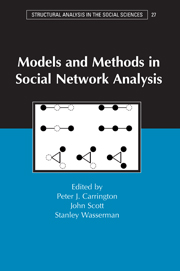Book contents
- Frontmatter
- Contents
- Acknowledgments
- Contributors
- 1 Introduction
- 2 Recent Developments in Network Measurement
- 3 Network Sampling and Model Fitting
- 4 Extending Centrality
- 5 Positional Analyses of Sociometric Data
- 6 Network Models and Methods for Studying the Diffusion of Innovations
- 7 Using Correspondence Analysis for Joint Displays of Affiliation Networks
- 8 An Introduction to Random Graphs, Dependence Graphs, and p*
- 9 Random Graph Models for Social Networks: Multiple Relations or Multiple Raters
- 10 Interdependencies and Social Processes: Dependence Graphs and Generalized Dependence Structures
- 11 Models for Longitudinal Network Data
- 12 Graphic Techniques for Exploring Social Network Data
- 13 Software for Social Network Analysis
- Index
- Structural Analysis in the Social Sciences
4 - Extending Centrality
Published online by Cambridge University Press: 05 June 2012
- Frontmatter
- Contents
- Acknowledgments
- Contributors
- 1 Introduction
- 2 Recent Developments in Network Measurement
- 3 Network Sampling and Model Fitting
- 4 Extending Centrality
- 5 Positional Analyses of Sociometric Data
- 6 Network Models and Methods for Studying the Diffusion of Innovations
- 7 Using Correspondence Analysis for Joint Displays of Affiliation Networks
- 8 An Introduction to Random Graphs, Dependence Graphs, and p*
- 9 Random Graph Models for Social Networks: Multiple Relations or Multiple Raters
- 10 Interdependencies and Social Processes: Dependence Graphs and Generalized Dependence Structures
- 11 Models for Longitudinal Network Data
- 12 Graphic Techniques for Exploring Social Network Data
- 13 Software for Social Network Analysis
- Index
- Structural Analysis in the Social Sciences
Summary
Introduction
Centrality is one of the most important and widely used conceptual tools for analyzing social networks. Nearly all empirical studies try to identify the most important actors within the network. In this chapter, we discuss three extensions of the basic concept of centrality. The first extension generalizes the concept from that of a property of a single actor to that of a group of actors within the network. This extension makes it possible to evaluate the relative centrality of different teams or departments within an organization, or to assess whether a particular ethnic minority in a society is more integrated than another. The second extension applies the concept of centrality to two-mode data in which the data consist of a correspondence between two kinds of nodes, such as individuals and the events in which they participate. In the past, researchers have dealt with such data by converting them to standard network data (with considerable loss of information); the objective of the extension discussed here is to apply the concept of centrality directly to the two-mode data. The third extension uses the centrality concept to examine the core-periphery structure of a network.
It is well-known that a wide variety of specific measures have been proposed in the literature dating back at least to the 1950s with the work of Katz (1953). Freeman (1979) imposed order on some of this work in a seminal paper that categorized centrality measures into three basic categories – degree, closeness, and betweenness – and presented canonical measures for each category.
- Type
- Chapter
- Information
- Models and Methods in Social Network Analysis , pp. 57 - 76Publisher: Cambridge University PressPrint publication year: 2005
- 138
- Cited by



